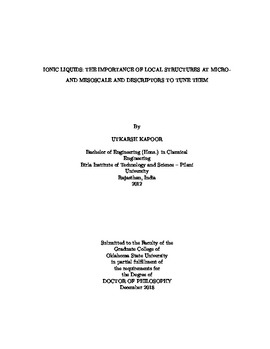| dc.contributor.advisor | Shah, Jindal Kiritkumar | |
| dc.contributor.author | Kapoor, Utkarsh | |
| dc.date.accessioned | 2019-07-19T13:33:34Z | |
| dc.date.available | 2019-07-19T13:33:34Z | |
| dc.date.issued | 2018-12-01 | |
| dc.identifier.uri | https://hdl.handle.net/11244/320939 | |
| dc.description.abstract | Ionic liquids (ILs) are novel chemical substances composed entirely of ions. The negligible vapor pressure coupled with the ability to design an IL by judicious choice of cations and anions or their substituent functional groups makes them attractive candidates for replacement of volatile organic compounds used in the chemical industry. According to one estimate, as many as one million ILs could be designed from the available cation-anion combinations. However, trial-and-error based experimentation approach of synthesizing new ILs and measuring properties to identify an IL suitable for a given task is expensive and inefficient. The need for fast and efficient discovery of new materials mandates that we recognize and develop design principles to screen materials without a priori knowledge of their properties. This dissertation is primarily directed towards designing ILs for a particular application by understanding molecular interactions, responsible for their macroscopic properties, using molecular simulations approach. The first part of the dissertation focuses on efforts to design or screen binary mixtures of ILs for tuning phase equilibria properties. The results indicate a structure-property correlation, at least qualitatively, between significant differences in molar volume and hydrogen-bond acceptor ability of the anions, that constitute the mixture, and molecular organization of ions within the mixture. This relationship allows us to fundamentally envisage the presence of ideal/non-ideal characteristics, which can further be exploited for better CO2 absorption, relative to pure IL analogues, making them potential candidates for the application of gas separation processes. The second part of the dissertation focuses on engineering the self-assembly of amphiphilic ILs bearing long-alkyl chains, that exhibit liquid crystal-like behavior relevant for applications such as reaction media, liquid crystalline biosensors, synthesis of nanoparticles, and storage and stabilization of biological materials. For the simultaneous presence of nonpolar moieties on both cation and anion, the morphology at mesoscopic scale changes from sponge-like (less ordered) to layer-like (highly ordered) with an increase in cationic alkyl chain length, provided alkyl chain on the anion is long enough to show nanoscale segregation singlehandedly. Further, for an optimum combination of cationic and anionic chain length nanoscale heterogeneities spanning over multiple length scales are observed; the aggregation behavior of which can be further tuned by the addition of another, less amphiphilic, IL and dilution with organic solvents such as water. Insights obtained from this work suggests that the vital step towards engineering the morphologies at different length scales is the ability to tune the relevant interparticle interactions. | |
| dc.format | application/pdf | |
| dc.language | en_US | |
| dc.rights | Copyright is held by the author who has granted the Oklahoma State University Library the non-exclusive right to share this material in its institutional repository. Contact Digital Library Services at lib-dls@okstate.edu or 405-744-9161 for the permission policy on the use, reproduction or distribution of this material. | |
| dc.title | Ionic Liquids: The Importance of Local Structures at Micro- and Mesoscale and Descriptors to Tune Them | |
| dc.contributor.committeeMember | Ramsey, Joshua D. | |
| dc.contributor.committeeMember | Ford Versypt, Ashlee | |
| dc.contributor.committeeMember | Fennell, Christopher Joseph | |
| osu.filename | Kapoor_okstate_0664D_16001.pdf | |
| osu.accesstype | Open Access | |
| dc.description.department | Chemical Engineering | |
| dc.type.genre | Dissertation | |
| dc.type.material | Text | |
